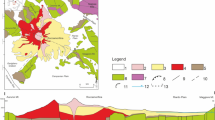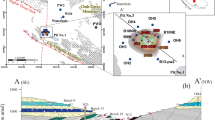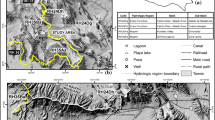Abstract
The Eocene deposits of Kazan Basin in Turkey contain a rare trona mineral which is planned to be extracted by solution mining. The complex flow dynamics and mixing mechanisms as noted from previous hydraulic and hydrochemical data need to be augmented with environmental tracer and noble gas data to develop a conceptual model of the system for the assessment of the impacts of the mining and to develop sustainable groundwater management policies throughout the area. The tracers used include the stable isotopes of water (δ2H, δ18O), δ13C and 14C of dissolved inorganic carbon (DIC), tritium (3H), the chlorofluorocarbons CFC-11 and CFC-12, and the noble gases He and Ne. The system studied consists of three aquifers: shallow, middle, and deep. CFC data indicate modern recharge in the shallow system. The estimates of ages through 14C dating for the deeper aquifer system are up to 34,000 years. Helium concentrations cover a wide range of values from 5 × 10−8 to 1.5 × 10−5 cm3 STP/g. 3He/4He ratios vary from 0.09RA to 1.29RA (where RA is the atmospheric 3He/4He ratio of 1.384 × 10−6), the highest found in water from the shallow aquifer. Mantle-derived 3He is present in some of the samples indicating upward groundwater movement, possibly along a NE–SW-striking fault-like feature in the basin.
Résumé
Les dépôts de l’Eocène du bassin de Kazan en Turquie contiennent du trona, minéral rare qui est prévu d’être exploité par extraction minière par dissolution. La dynamique complexe des écoulements et les mécanismes de mélange tels qu’identifiés à partir de données hydrauliques et hydrochimiques antérieures nécessitent d’être complétés par des données issues de traceurs environnementaux et de gaz rares afin d’établir un modèle conceptuel du système pour l’évaluation des impacts de la mine et pour élaborer des politiques de gestion durable des eaux souterraines dans toute la zone. Les traceurs utilisés comprennent les isotopes stables de l’eau (δ2H, δ18O), δ13C et le 14C du carbone inorganique dissous, le tritium (3H), les chlorofluorocarbones CFC-11 et CFC-12, et les gaz nobles He et Ne. Le système étudié consiste en trois aquifères : peu profond, intermédiaire et profond. Les données de CFC indiquent une recharge actuelle du système peu profond. Les âges estimés avec la datation au 14C pour le système aquifère le plus profond atteignent les 34,000 ans. Les concentrations en Hélium couvrent une large plage de valeurs de 5 × 10−8 à 1.5 × 10−5 cm3 STP/g. Les rapports de 3He/4He varient de 0.09RA à 1.29RA (oû RA est le rapport atmosphérique 3He/4He de 1.384 × 10−6), les valeurs les plus élevées sont trouvées dans les eaux de l’aquifère peu profond. 3He d’origine mantellique est présent dans certains des échantillons indiquant des flux verticaux ascendants des eaux souterraines, probablement le long de la structure faillée NE–SW dans le bassin.
Resumen
Los depósitos del Eoceno de la cuenca de Kazan en Turquía contienen natrón, un mineral poco frecuente que está planificado extraer por solución. La compleja dinámica de flujo y los mecanismos de mezcla indicados de datos hidráulicos e hidroquímicos previos necesitaron ser detallados a partir de trazadores ambientales y gases nobles con el objeto de desarrollar un modelo conceptual del sistema para la evaluación de los impactos de la minería y para desarrollar políticas de manejo sustentable en el área. Los trazadores usados incluyen a los isótopos estables del agua (δ2H, δ18O), δ13C y 14C de carbono inorgánico disuelto (DIC), tritio (3H), los clorofluorocarbonos CFC-11 y CFC-12, y los gases nobles He y Ne. El sistema estudiado consiste de tres acuíferos: somero, medio y profundo. Los datos de CFC indican una recarga reciente en el sistema somero. La estimación de edades a través de la datación de 14C para el sistema acuífero más profundo son de hasta 34,000 años. Las concentraciones de Helio cubren un amplio rango de valores de 5 × 10−8 a 1.5 × 10−5 cm3 STP/g. Las relaciones 3He/4He varían desde 0.09RA a 1.29RA (donde RA es la relación atmosférica 3He/4He de 1.384 × 10−6), las más altas encontradas en el agua del acuífero somero. Capas derivadas de 3He están presentes en algunas de las muestras indicando un movimiento de agua subterránea hacia arriba, posiblemente a lo largo de una característica falla de rumbo NE–SW existente en la cuenca.
摘要
土耳其Kazan流域始新世沉积层含稀有的天然碱矿物,这种矿物计划采用溶解开采法开采。根据早先水力资料和水化学资料所记载的复杂的水流动力学和混合机理信息需要补充环境示踪剂和惰性气体方面的资料,以开发系统的概念模型用于评价开采产生的影响及制定整个地区可持续的地下水管理政策。使用的示踪剂包括水中的(δ2H, δ18O)、溶解无机碳(DIC)中的 δ13C 和 14C、氚(3H)、氯氟烃CFC-11和 CFC-12等同位素及惰性气体He 和 Ne。所研究的系统由三个含水层组成:浅层、中层和深层。CFC资料表明浅层系统中的补给为现代补给。通过14C测年估计深层含水层系统水的年龄达34,000年。氮含量的范围很广,从5 × 10−8 到 1.5 × 10−5 cm3 STP/g不等。3He/4He的比值从0.09RA 到 1.29RA(RA为1.384 × 10−6大气3He/4He比值),最 高的比值发现于浅层含水层的水中。幔源3He存在于一些样品中,表明地下水可能沿着流域内NE–SW走向的断层状构造向上运移。
Resumo
Os depósitos eocénicos da Bacia de Kazan, na Turquia, contêm minerais raros de trona que se prevêem explorar através de mineração por dissolução. O complexo hidrodinamismo e mecanismos de mistura, verificados através de dados hidráulicos e hidroquímicos, têm de ser melhor estudados com recurso a traçadores ambientais e gases nobres, de modo a desenvolver um modelo concetual do sistema para a avaliação dos impactes da mineração e para desenvolver políticas de gestão sustentável da água subterrânea. Os traçadores usados incluem os isótopos estáveis da água (δ2H, δ18O), δ13C e 14C do carbono inorgânico dissolvido (CID), trítio (3H), clorofluorcarbonetos CFC-11 e CFC-12, e os gases nobres He e Ne. O sistema estudado é constituído por três aquíferos: subsuperficial, médio e profundo. Os dados de CFC indicam recarga moderna no sistema subsuperficial. As estimativas de idades, através da datação com 14C, para o sistema aquífero profundo, vão até 34,000 anos. As concentrações de hélio cobrem uma vasta gama de valores, de 5 × 10−8 a 1.5 × 10−5 cm3 STP/g. As razões 3He/4He variam de 0.09RA a 1.29RA (onde RA é a razão atmosférica 3He/4He de 1.384 × 10−6), tendo a mais elevada sido encontrada na água do aquífero subsuperficial. 3He de origem mantélica está presente em algumas amostras, indicando um movimento ascendente da água subterrânea, possivelmente ao longo de uma estrutura NE–SW, do tipo falha de desligamento, existente na bacia.













Similar content being viewed by others
References
Aeschbach-Hertig W, Schlosser P, Stute M, Simpson HJ, Ludin A, Clark JF (1998) A 3H/3He study of ground water flow in a fractured bedrock aquifer. Ground Water 36:661–670
Aeschbach-Hertig W, Peeters F, Beyerle U, Kipfer R (2000) Palaeotemperature reconstruction from noble gases in ground water taking into account equilibration with entrapped air. Nature 405:1040–1044
Apaydin A (2004) Study of recharge and conditions of Cakiloba-Karadoruk aquifer system (western Beypazari-Ankara). PhD Thesis, Hacettepe University, Turkey
Arslan S (2008) Investigation of the recharge and discharge mechanisms of a complex aquifer system by using environmental isotopes and noble gases. PhD Thesis, Middle East Technical University, Turkey
Arslan S, Yazicigil H, Stute M, Schlosser P (2013) Environmental isotopes and noble gases in the deep aquifer system of Kazan Trona Ore Field, Ankara, central Turkey and links to paleoclimate. Quat Res 79:292–303
ASTM (1999) Standard test methods for low-level dissolved oxygen in water. D5543-94, ASTM, West Conshohocken, PA
Bayari CS, Ozyurt NN, Kilani S (2009) Radiocarbon age distribution of groundwater in the Konya Closed Basin, Central Anatolia, Turkey. Hydrogeol J 17:347–365
Bethke MC, Johnson TM (2008) Groundwater age and groundwater age dating. Annu Rev Earth Planet Sci 36:121–152
Bottema S, van Zeist W (1981) Palynological evidence for the climatic history of the near East, 50,000–6,000 BP. Paper presented at the Prehistoire du Levant, Paris, 1981, CNRS, Paris
Bullister JL (2011) Atmospheric CFC-11, CFC-12, CFC-113, CCl4 and SF6 histories. Carbon Dioxide Information Analysis Center, Oak Ridge National Laboratory, US DOE, Oak Ridge, TN. doi:10.3334/CDIAC/otg.CFC_Hist. Available at http://cdiac.ornl.gov/ftp/oceans/CFC_ATM_Hist/. Accessed 15 Dec 2013
Busenberg E, Plummer LN (1992) Use of chlorofluorocarbons (CCl3F and CCl2F2) as hydrologic tracers and age-dating tools: the alluvium and terrace system of central Oklahoma. Water Resour Res 28:2257–2283
Busenberg E, Plummer LN (2000) Dating young groundwater with sulfur hexafluoride: natural and anthropogenic sources of sulfur hexafluoride. Water Resour Res 36:3011–3030
Camur MZ, Er C, Yazicigil H (2008) Modeling of lithology induced chemical anomalies in the aquifer systems of the Kazan Trona deposit area, Ankara, Turkey. Environ Geol 54:777–789
Castro MC, Stute M, Schlosser P (2000) Comparison of 4He ages and 14C ages in simple aquifer systems: implications for groundwater flow and chronologies. Appl Geochem 15:1137–1167
Cetin B, Unc E, Uyar G (2002) The moss flora of Ankara-Kizilcahamam-Camkoru and Camlidere districts. Turk J Bot 26:91–101
Clark I, Fritz P (1997) Environmental isotopes in hydrogeology. CRC, Boca Raton, FL
Clark JF, Stute M, Schlosser P, Drenkard S (1997) A tracer study of the Floridan aquifer in southeastern Georgia: implications for groundwater flow and paleoclimate. Water Resour Res 33:281–289
Clarke WB, Jenkins WJ, Top Z (1976) Determination of tritium by mass-spectrometric measurement of 3He. Int J App Radiat Isot 27:515–522
Cook PG, Favreau G, Dighton JC, Tickell S (2003) Determining natural groundwater influx to a tropical river using radon, chlorofluorocarbons and ionic environmental tracers. J Hydrol 277:74–88
Craig H (1961) Isotopic variations in meteoric waters. Science 133:1702–1703
Drimmie RJ, Shouakar-Stash O, Walters R, Heemskerk AR (2001) Hydrogen isotope ratio by automatic, continuous flow, elemental analyses, and isotope ratio mass spectrometry. University of Waterloo, Waterloo, ON, 8 pp
DSI (1975) Ankara-Murted Plain hydrogeological investigation report. General Directorate of State Hydraulic Works (DSI), Ankara, 49 pp
Dunkle SA, Plummer LN, Busenberg E, Phillips PJ, Denver J, Hamilton PA, Michel RL, Coplen TB (1993) Chlorofluorocarbons (CCl3F and CCl2F2) as dating tools and hydrologic tracers in shallow groundwater of the Delmarva Peninsula, Atlantic Coastal-Plain, United States. Water Resour Res 29:3837–3860
Eberts SM, Böhlke JK, Kauffmann J, Jurgens BC (2012) Comparison of particle-tracking and lumped-parameter age distribution models for evaluating vulnerability of production wells to contamination. Hydrogeol J 20:263–282
Epstein S, Mayeda T (1953) Variation of O18 content of waters from natural sources. Geochim Cosmochim Acta 4:213–224
Gilbert TW, Behymer TD, Castaneda HB (1982) Determination of dissolved-oxygen in natural and wastewaters. Am Lab 14:119–134
Global Network of Isotopes in Precipitation (2006) The GNIP database. Available at http://www-naweb.iaea.org/napc/ih/IHS_resources_gnip.html. Accessed 15 Dec 2013
Jenkins WJ, Clarke WB (1976) Distribution of 3He in western Atlantic Ocean. Deep-Sea Res 23:481–494
Kazanci N, Gokten E (1988) Lithofacies features and tectonic environment of the continental Paleocene volcanoclastics in Ankara region. METU J Pure Appl Sci 21:271–282
Kocyigit A, Lunel AT (1987) Geology and tectonic setting of Alci region, Ankara. METU J Pure Appl Sci 20:35–57
Kocyigit A, Ozkan S, Rojay B (1988) Examples from fore-arc basin remnants of the active margin of northern Neo-Tethys: development and emplacement ages of the Anatolian Nappes, Turkey. METU J Pure Appl Sci 21:183–210
Kulongoski JT, Hilton DR, Izbicki JA (2003) Helium isotope studies in the Mojave Desert, California: implications for groundwater chronology and regional seismicity. Chem Geol 202:95–113
Ludin A, Weppernig R, Boenisch G, Schlosser P (1998) Mass spectrometric measurement of helium isotopes and tritium. Lamont-Doherty Earth Observatory, New York
Mamyrin BA, Tolstikhin IN (1984) Helium isotopes in nature. Elsevier, Amsterdam
Martel DJ, Deak J, Dovenyi P, Horvath F, Onions RK, Oxburgh ER, Stegena L, Stute M (1989) Leakage of helium from the Pannonian Basin. Nature 342:908–912
Marty B, Torgersen T, Meynier V, Onions RK, Demarsily G (1993) Helium isotope fluxes and groundwater ages in the Dogger Aquifer, Paris Basin. Water Resour Res 29:1025–1035
Newman BD, Osenbrück K, Aeschbach-Hertig W, Solomon DK, Cook P, Różański K, Kipfer R (2010) Dating of ‘young’ groundwaters using environmental tracers: advantages, applications, and research needs. Isot Environ Health Stud 46:259–278
Pearson FJ (1965) Use of 13C/12C ratios to correct radiocarbon ages of material initially diluted by Limestone. 6th Int. Conf. on Radiocarbon and Tritium Dating, Pullman, WA, June 1865, 357 pp
Pearson FJ, Hanshaw BB (1970) Sources of dissolved carbonate species in groundwater and their effects on Carbon-14 dating. Paper presented at the Symp. on Isotope Hydrology, Vienna, March 1970
Plummer LN, Busenberg E (2000) Chlorofluorocarbons. In: Cook PG, Herczeg AL (eds) Environmental tracers in subsurface hydrology. Kluwer, Dordrecht, The Netherlands
Plummer LN, Busenberg E, Han LF (2006) Data interpretation in representative cases. In: Use of chlorofluorocarbons in hydrology: a guidebook, chap 8. IAEA, Vienna, pp 105–134
Poreda RJ, Cerling TE, Salomon DK (1988) Tritium and helium isotopes as hydrologic tracers in a shallow unconfined aquifer. J Hydrol 103:1–9
Prentice IC, Guiot J, Harrison SP (1992) Mediterranean vegetation, lake levels and paleoclimate at the last glacial maximum. Nature 360:658–660
Robertson WD, Cherry JA (1989) Tritium as an indicator of recharge and dispersion in a groundwater system in central Ontario. Water Resour Res 25:1097–1109
Rojay B, Toprak V, Bozkurt E (2002) Core sample analysis in Kazan Soda Project Area. Middle East Technical University, Ankara
Samborska K, Rózkowski A, Maloszewski P (2013) Estimation of groundwater residence time using environmental isotopes (14C, T) in carbonate aquifers, southern Poland. Isot Environ Health Stud 49:73–97
Sanford W (2011) Calibration of models using groundwater age. Hydrogeol J 19:13–16
Schlosser P, Stute M, Dorr H, Sonntag C, Munnich KO (1988) Tritium/3He dating of shallow groundwater. Earth Planet Sci Lett 89:353–362
Schlosser P, Stute M, Sonntag C, Munnich KO (1989) Tritiogenic 3He in shallow groundwater. Earth Planet Sci Lett 94:245–256
Shapiro SD, Schlosser P, Smethie WM, Stute M (1997) The use of 3H and tritiogenic 3He to determine CFC degradation and vertical mixing rates in Framvaren Fjord, Norway. Mar Chem 59:141–157
Smethie WM, Fine RA, Putzka A, Jones EP (2000) Tracing the flow of North Atlantic Deep Water using chlorofluorocarbons. J Geophys Res Oceans 105:14297–14323
Solomon DK, Sudicky EA (1991) Tritium and 3He isotope ratios for direct estimation of spatial variations in groundwater recharge. Water Resour Res 27:2309–2319
Solomon DK, Genereux DP, Plummer LN, Busenberg E (2010) Testing mixing models of old and young groundwater in a tropical lowland rain forest with environmental tracers. Water Resour Res 46, W04518
SRK (2001) Hydrogeology: conceptual understanding. Kazan Trona Project report, Ankara, Turkey
SRK (2003) Water supply assessment. Kazan Trona Project report, Ankara, Turkey
SRK (2004) Hydrogeological modeling. Kazan Trona Project report, Ankara, Turkey
Stute M, Deak J (1989) Environmental isotope study (14C, 13C, 18O, D, noble gases) on deep groundwater circulation systems in Hungary with reference to paleoclimate. Radiocarbon 31:902–918
Stute M, Schlosser P, Clark JF, Broecker WS (1992a) Paleotemperatures in the southwestern United States derived from noble gases in ground water. Science 256:1000–1003
Stute M, Sonntag C, Deak J, Schlosser P (1992b) Helium in deep circulating groundwater in the Great Hungarian Plain: flow dynamics and crustal and mantle helium fluxes. Geochim Cosmochim Acta 56:2051–2067
Stute M, Forster M, Frischkorn H, Serejo A, Clark JF, Schlosser P, Broecker WS, Bonani G (1995) Cooling of tropical Brazil (5-degrees-C) during the last glacial maximum. Science 269:379–383
Stute M, Deak J, Revesz K, Bohlke JK, Deseo E, Weppernig R, Schlosser P (1997) Tritium/3He dating of river infiltration: an example from the Danube in the Szigetkoz area, Hungary. Ground Water 35:905–911
Szabo Z, Rice DE, Plummer LN, Busenberg E, Drenkard S (1996) Age dating of shallow groundwater with chlorofluorocarbons, tritium helium 3, and flow path analysis, southern New Jersey coastal plain. Water Resour Res 32:1023–1038
Toprak V, Rojay B (2000) Geology baseline study for the Kazan Soda Project Area. Middle East Technical University, Ankara
Toprak V, Rojay B (2001) Geological investigation in Kazan Soda Project Area. Middle East Technical University, Ankara
Torgersen T, Stute M (2013) Helium (and other noble gases) as a tool for understanding long time-scale groundwater transport. In: Isotope methods for dating old groundwater, IAEA, Vienna, pp 179–216
US Geological Survey (2011) The Reston Chlorofluorocarbon Laboratory, US Geological Survey, Reston, VA. http://water.usgs.gov/lab/. Accessed 15 Dec 2013
Varni M, Carrera J (1998) Simulation of groundwater age distributions. Water Resour Res 34:3271–3281
Warner MJ, Weiss RF (1985) Solubilities of chlorofluorocarbon-11 and chlorofluorocarbon-12 in water and seawater. Deep-Sea Res 32:1485–1497
Weise SM (1986) Heliumisotopen: Gehalte im Grundwasser—Messung und Interpretation [Helium isotopes: contents in groundwater—measurements and interpretation]. PhD Thesis, University of München, Germany
Weise SM, Moser H (1987) Groundwater dating with helium isotopes. In: Techniques in water resources development, IAEA, Vienna, pp 105–126
Weiss RF (1968) Piggyback samplers for dissolved gas studies on sealed water samples. Deep-Sea Res 15:695–699
Weissmann GS, Zhang Y, LaBolle EM, Fogg GE (2002) Dispersion of groundwater age in an alluvial aquifer system. Water Resour Res 38(10):1198
Wick L, Lemcke G, Sturm M (2003) Evidence of Lateglacial and Holocene climatic change and human impact in eastern Anatolia: high-resolution pollen, charcoal, isotopic and geochemical records from the laminated sediments of Lake Van, Turkey. The Holocene 13:665–675
Woods Hole Oceanographic Institution (2011) NOSAMS, National Ocean Sciences Accelerator Mass Spectrometry Facility. http://www.whoi.edu/nosams/. Accessed 08 Aug 2014
Yager RM, Plummer LN, Kauffman LJ, Doctor DH, Nelms DL, Schlosser P (2013) Comparison of age distributions estimated from environmental tracers by using binary-dilution and numerical models of fractured and folded karst: Shenandoah Valley of Virginia and West Virginia, USA. Hydrogeol J 21:1193–1217
Yazicigil H, Doyuran V, Camur MZ, Duru U, Sakiyan J, Yilmaz KK, Toprak FO, Pusatli T (2001) Hydrogeological–hydrogeochemical baseline study of the Kazan Trona Project Area. Middle East Technical University, Ankara, 355 pp
Yazicigil H, Er C, Ates JS, Camur MZ (2009) Effects of solution mining on groundwater quality in the Kazan Trona Field, Ankara-Turkey: model predictions. Environ Geol 57:157–172
Acknowledgements
Part of this study was supported by The Scientific and Technological Research Council of Turkey Environmental, Atmospheric, Earth and Marine Sciences Research Group (CAYDAG) Short-Term R&D Funding Program (1002) Project No. 106Y310. Sebnem Arslan was supported by the fellowship of Fulbright Commission of Turkey during her research at Lamont-Doherty Earth Observatory of Columbia University. The authors would like to thank Eugene Gorman for valuable assistances during CFC measurements, and Mehmet Ekmekci and Nilgun Gulec for their advice. The assistance of Faruk Suluki, Omer Kahraman, Ugur Ozturk and Lutfu Simsek in the field are appreciated. Special thanks to Riotur Mining Inc. for giving access to the hydrogeologic and hydrochemical data. The manuscript was considerably improved by constructive criticism and comments provided by reviewers, including C. Kohfahl, M. Currell and J. Führböter.
Author information
Authors and Affiliations
Corresponding author
Rights and permissions
About this article
Cite this article
Arslan, S., Yazicigil, H., Stute, M. et al. Analysis of groundwater dynamics in the complex aquifer system of Kazan Trona, Turkey, using environmental tracers and noble gases. Hydrogeol J 23, 175–194 (2015). https://doi.org/10.1007/s10040-014-1188-z
Received:
Accepted:
Published:
Issue Date:
DOI: https://doi.org/10.1007/s10040-014-1188-z




